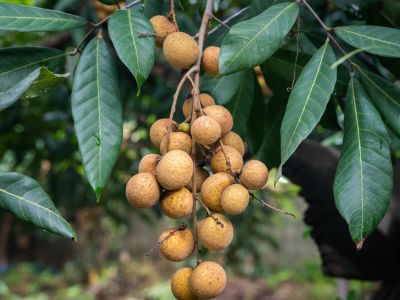Dragon’s Eye Plant Info
If you are a gardener who is interested in unique plant specimens and has an adventurous palate, the dragon’s eye tree (Dimocarpus longan) may be of interest. Its name derives from the shelled fruit, which is said to resemble an eyeball. This fruiting tree is a less sweet substitute for the infamous lychee nut. The fruit is easily separated from the aril, just as in lychee, and it is a common food crop that is preserved frozen, canned, or dried, and also marketed fresh. Some tips on how to grow a dragon’s eye can help you harvest the low-calorie, high potassium fruit. Dragon’s eye is a 30- to 40-foot (9-12 m.) tree with rough bark and elegant drooping branches. Plants are also called longan trees and are in the soapberry family. The leaves are pinnately compound, glossy, leathery, and dark green, growing 12 inches (30.5 cm.) long. New growth is wine-colored. The flowers are pale yellow, borne on racemes, and have 6 petals on hairy stalks. The fruits are drupes and arrive in clusters. Among the economic dragon’s eye plant info is its importance as a crop in Florida. Fruits produce later in the season than lychee, and trees grow quickly and thrive in a variety of soil types. However, seedlings can take up to 6 years to bear fruit, and in some years, fruit production is erratic.
How to Grow Dragon’s Eye Plants
Site is the first selection when growing dragon’s eye plants. Choose a full sun location away from other large plants and buildings where the soil drains freely and no flooding occurs. Trees can tolerate sandy soils, sandy loam, and even calcareous, rocky soils but do prefer an acidic environment. Young trees are less fussy about climactic conditions than their cousin, the lychee, but should be planted where buffeting winds do not occur. When planting a grove or multiple trees, space longans 15 to 25 feet (4.5-7.5 m.) apart, depending upon whether you will be pruning to keep trees smaller and easier to harvest. Most propagation of dragon’s eye tree is through cloning, as seedlings are unreliable.
Dragon’s Eye Care
Dragon’s eye trees require less water than lychee. Young trees need consistent irrigation as they establish and mature trees should get regular water from flowering to harvest. Some drought stress during fall and winter may promote flowering in spring. Feed young trees every 6 to 8 weeks with a 6-6-6. Foliar feeds work well on mature plants from spring through fall. Apply 4 to 6 times during the growing season. Mature trees need 2.5 to 5 pounds (1-2.5 kg.) per application. In California, the trees are considered to be pest free, but in Florida, they are attacked by scale and lychee webworms. Trees have no major disease issues.
